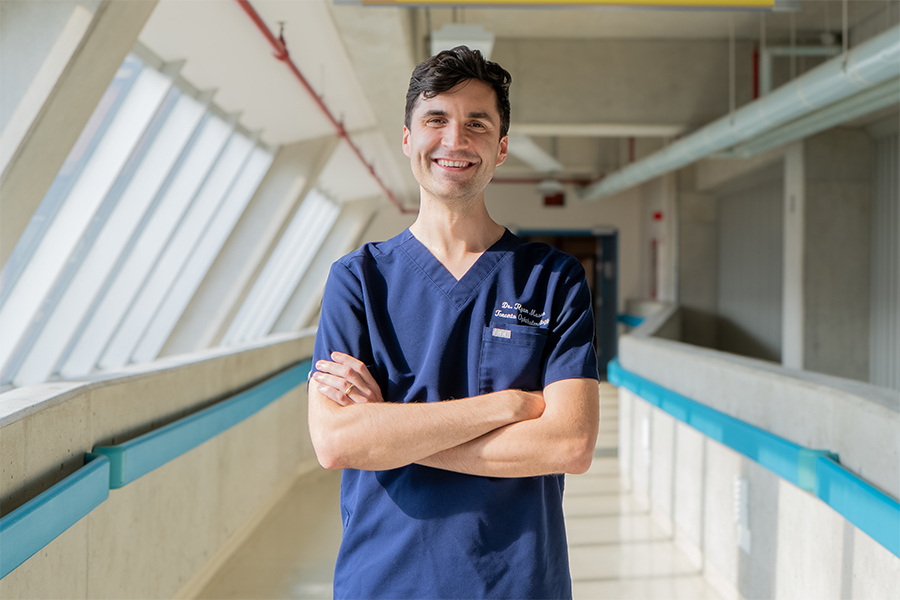
More than 5.5 million Canadians live with an eye disease that could cause sight loss such as glaucoma, and age-related macular degeneration and cataracts. This number is expected to double over the next 20 years. The good news is that many causes of vision loss are preventable or treatable.
Dr. Ryan Mason, Comprehensive Ophthalmologist at UHN’s Donald K. Johnson Eye Institute, addresses some commonly asked vision questions and share insights on how to maintain good eye health and prevent vision loss.
What is “normal” vision? What are common types of visual impairment?
“Normal” vision refers to the ability to see clearly at standard distances without correction. 20/20 vision is considered as “normal” vision, which means that at 20 feet, you can see what the average person should be able to see at that distance. In other words, it reflects a certain clarity of vision, not necessarily “perfect” eyesight, since vision also involves colour and peripheral awareness.
Common visual impairments include refractive errors such as nearsightedness (myopia) and farsightedness (hyperopia), and astigmatism (blurred vision due to an irregularly shaped cornea). Beyond these, some people develop ocular conditions such as cataracts, glaucoma, or macular degeneration. These can lead to more serious or permanent vision loss in a small percentage of those affected.
What are some tips for maintaining good eye health? How can I monitor my eye health?
Good eye health starts with good everyday habits. Eating a balanced diet, rich in leafy greens and fruits, supports healthy vision. Protecting your eyes from UV light with sunglasses and from injury with safety glasses is also important. Avoid smoking, since it increases the risk of certain conditions such as cataracts and macular degeneration. Managing general health is just as important, as conditions like diabetes and high blood pressure can affect the eyes.
The best way to monitor eye health is by scheduling regular eye exams, which can detect both common and rare eye conditions. Even if you don’t have symptoms, regular exams with an Optometrist or Ophthalmologist are important. Many eye diseases develop slowly and painlessly. Detecting them early often means more effective treatment and better long-term vision. Consistent eye care today can protect your sight for the future.
What happens during an eye exam?
An eye exam is a thorough check-up that evaluates both how well you see and the overall health of your eyes. It starts with a discussion of your vision and health history. Then, your visual acuity is measured using an eye chart, and lenses are tested to find if you need glasses or contact lenses. The eye doctor may check how your eyes move, focus, and work together. Using specialized lights and lenses, the doctor examines all aspects of your eye including the cornea, lens, retina, and optic nerve. Sometimes eye drops are used to dilate the pupils, giving a better view inside the eye.
Adults without any known eye diseases should schedule an eye exam every two to three years. For individuals over the age of 65, an annual eye exam is recommended to detect and monitor any age-related eye conditions.
How do I prevent dry eyes?
Dry eyes occur when your eyes don’t make enough tears or when tears evaporate too quickly. To help prevent this, stay hydrated and avoid overly dry environments. If you spend long hours at a computer or reading, remember to blink often and practise the “20-20-20 rule”—every 20 minutes take a short break and focus on something 20 feet away for 20 seconds. If you wear contact lenses, follow cleaning and replacement instructions carefully, and consider switching to glasses when your eyes feel irritated.
Over-the-counter artificial tears can relieve occasional dryness, and daily warm compresses for the eyes with 5-10 minutes of heat can improve your natural tear production. If dry eye symptoms are persistent, it’s best to see an eye specialist. Chronic dry eyes may be linked to medical conditions or medications, and tailored treatments can help restore comfort and protect your vision.
How can I tell if my vision changes are due to aging or a serious condition like macular degeneration or glaucoma?
Some vision changes are a normal part of aging. For example, presbyopia—difficulty seeing up close—typically begins in your 40s and is corrected with reading glasses. Cataracts, or clouding of the eye’s lens, also become more common with age and can often be treated with surgery. Blurred central vision, difficulty recognizing faces, or needing brighter light to read may signal macular degeneration. The challenge is that serious eye diseases often start quietly, without obvious symptoms until significant damage has occurred. For instance, glaucoma—damage to the optic nerve often related to high eye pressure—is often not noticed by patients until in the advanced stages of disease. That’s why regular eye exams are essential. Your eye doctor can distinguish between normal aging and early signs of disease, offering treatments to preserve vision. Finally, do not ignore sudden changes to your vision as prompt evaluation ensures the best chance of protecting your sight.
What should I know about visual impairment and blindness? How can I prevent vision loss?
Visual impairment refers to vision that cannot be fully corrected with glasses, contacts, or refractive surgery. It can range from mild vision loss to blindness. The good news is that many causes of vision loss are preventable or treatable. Protecting your vision starts with regular eye exams to detect problems early, even before symptoms appear. This is especially important if you have a family history of eye disease in your parents, siblings, or children. Managing health conditions like diabetes and high blood pressure also reduces the risk of vision-threatening complications. If vision loss does occur, low vision aids and rehabilitation services can help people remain independent and improve quality of life.
By: Sara Yuan
For more information on eye health, common eye diseases, treatment options and current research, visit UHN’s Donald K. Johnson Eye Institute.

No one ever changed the world on their own but when the bright minds at UHN work together with donors we can redefine the world of health care together.


